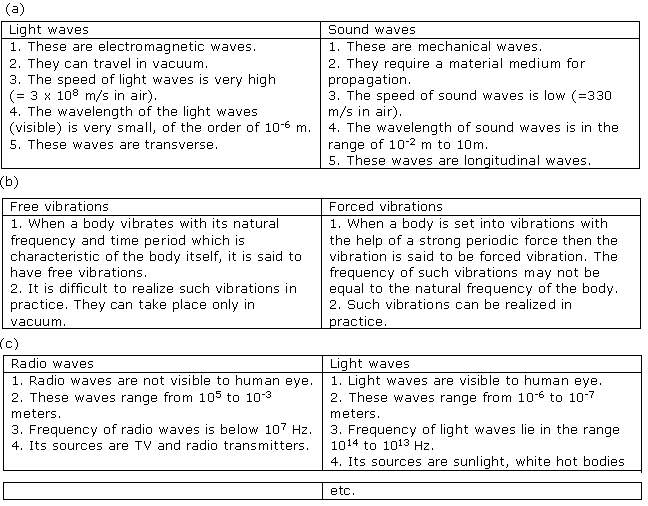Class 10 FRANK Solutions Physics Chapter 3 - Sound - Exercises and MCQ
Increase your exam score by practising Frank Solutions for ICSE Class 10 Physics Chapter 3 Sound Exercises and MCQ. With practice, you can write clear answers in your board exam on chapter concepts like sound waves, radio waves, velocity of sound, wavelength, frequency etc.
In addition, benefit from TopperLearning’s ICSE Class 10 Physics resources such as practice tests and revision notes whenever you need. We ensure easy availability of all the necessary resources on our study portal 24/7. In case you need any help from a Physics expert, feel free to visit our ‘UnDoubt’ section and get your doubts resolved.
Sound - Exercises and MCQ Exercise 148
Solution 12
Solution 1
Conditions necessary for echo formation are:
1. The minimum distance between the source of sound and its reflector should be 17 m.
2. Reflected sound should reach the person atleast 0.1 second after the original sound is heard.
Solution 2
Solution 3

Solution 4
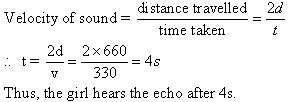
Solution 5
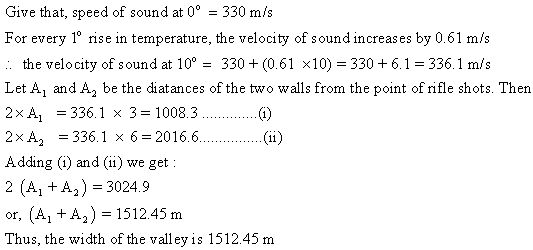
Solution 6
(b) Dolphins detect their enemies and small fishes by emitting ultrasonic waves in all directions and then hearing their reflected sound i.e. echo. Dolphins can judge the nature of obstacles or of small fish by hearing the echo and catch their prey.
Solution 7
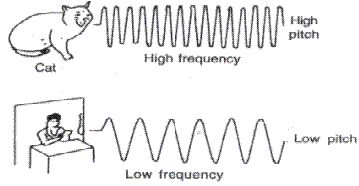
(b) Loudness: Loudness is the property by virtue of which a loud sound can be distinguished from a faint one, both having the same pitch and quality. The loudness of a sound depends on the amplitude (or intensity) of the wave.
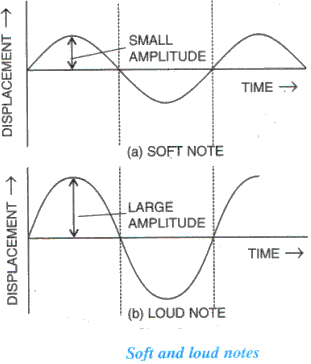
(c) Pitch: The 'pitch' of a note is determined solely by its frequency. The pitch in fact, is a subjective sensation in the ear depending only upon the frequency of the musical note. The relation between pitch and frequency is linear to a very close approximation.
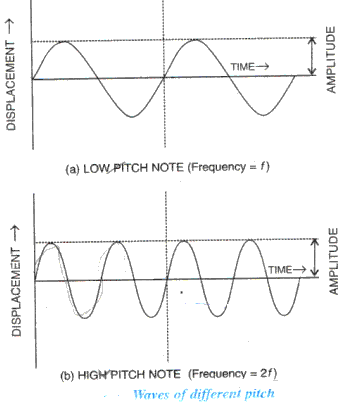
(d) Quality of a musical note: quality of a sound is that characteristic which distinguishes the two sounds of the same loudness and same pitch, but emitted by two different instruments. It depends on the waveform.
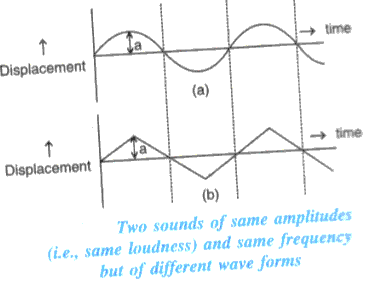
Solution 8
Wave- velocity: It is the velocity with which a wave propagates in a particular medium.
Wavelength: The wavelength is the distance between two successive crests or two successive troughs on a transverse wave.
It is also equal to the distance between any two points where the particles are passing through their respective mean positions in the same direction.
It is also the distance between two successive compressions or two successive rarefactions on a longitudinal wave.
Wave-velocity = wavelength x frequency
Solution 9

Solution 10
Loudness depends upon the amplitude of the wave. Loudness is directly proportional to the square of amplitude.
Quality of a musical depends on the wave form.
Solution 11


Solution 13
1. Frequency of the fundamental note of a stretched string is inversely proportional to the length of the vibrating string.
2. Frequency is directly proportional to the square root of the tension of the string.
3. Frequency is inversely proportional to the square root of linear density. That is, mass per unit length of the material of the string. Thinner is the wire, higher is the frequency.
Solution 14
E.g.1 all stringed instruments are provided with sound box (or sound chamber). This box is so constructed that the column of of air inside it, has a natural frequency which is the same as that of the strings stretched on it, so that when the strings are made to vibrate, the air column inside the box is set to forced vibrations. Since the sound box has a large area, it sets a large volume of air into vibration of the same frequency as that of the string. So, due to resonance, a loud sound is produced.
E.g.2 Radio and TV receivers have electronic circuits which produce electrical vibrations, the frequency of which can be changed by changing the values of the electrical components of that circuit. When we want to tune a radio or TV receiver, we merely adjust the values of the electronic components to produce vibrations of frequency equal to that of the incoming radio waves which we want to receive. When the two frequencies match, due to resonance, the energy or signal of that particular frequency is received from the incoming waves. The signal is then amplified in the receiver set.
Solution 15
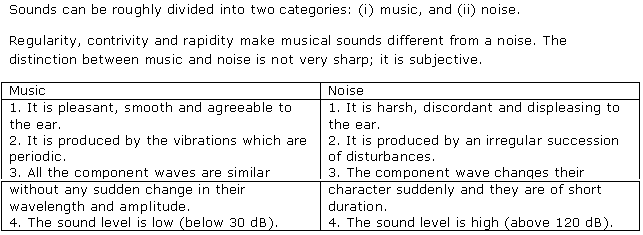
Solution 16
Guitar produces notes using vibrating string.
To produce notes with different pitches, strings of different thicknesses are plucked. When a string of greater thickness is plucked, a note with higher pitch is produced and vice-versa.
To produce the notes of different loudness, all stringed instruments are provided with hollow sound box which contains air. In these instruments vibrations are produced in the sound box when the strings on it are made to vibrate by plucking, are forced vibrations. Larger the surface area of the air in the sound box, louder will be the sound produced.
(b)
Flute produces notes using a vibrating column of air.
In a flute, the notes of different frequencies or pitch are produced by changing the effective length of the air column when different holes in it are closed.
In a flute, the notes of different loudness can be produced by using flutes of different diameters. A flute with larger diameter shall have more air enclosed in it and hence the sound produced by it shall be louder.
(c)
Piano produces notes using a vibration of any other body.
When we strike the keys of piano, strings of different thickness are set in vibration at their natural frequencies; hence sound of higher pitch can be produced by striking the string of greater thickness.
A piano's wires are attached to a sounding board with help of which sound of different loudness can be produced. The vibrating wire makes the board vibrate, which makes the sound louder.
Solution 17
When a nail is hammered into a piece of wood, its length outside wood gradually decreases. As the length decreases, the frequency of vibrations increases and hence the pitch being directly proportional to the frequency also increases
(b)
When the windows rattle, at that moment, its natural frequency corresponds with the frequency with which the low notes of a pipe organ are sounded. Thus, resonance takes place which makes the windows to vibrate violently.
Sound - Exercises and MCQ Exercise 149
Solution 18
Solution 19
Solution 20
Solution 21
Solution 22
Solution 23
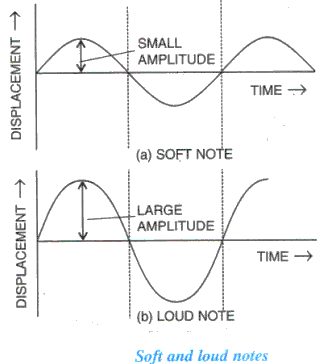
The loudness of a sound wave is determined by its amplitude; it is proportional to the square of the amplitude. Therefore, the louder sound corresponds to the wave of larger amplitude.
Solution 24
Solution 25
Its unit is microwatt per metre2.
Solution 26
L = k log (I/Io),
Here, I/Io is the intensity level of the sound or the ratio between its intensity I and the threshold intensity Io, and k is the constant of proportionality depending upon the unit chosen.
Solution 27
(b) If amplitude of a musical sound is increased, its loudness will also increase.
Solution 28
Further, two sounds of the same intensity, but of different frequencies may differ in loudness even to the same listener because the sensitivity of the ears is different for different frequencies. Thus loudness is a subjective quantity, while intensity, being a measurable quantity, is an objective quantity for a sound wave.
Solution 29
1. Loudness is directly proportional to the square of the amplitude.
2. Loudness varies inversely as the square of distance.
3. Loudness is directly proportional to the surface area of a vibrating body.

